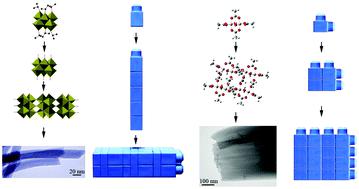Our official English website, www.x-mol.net, welcomes your feedback! (Note: you will need to create a separate account there.)
Synthesizing 1D and 2D metal oxide nanostructures: using metal acetate complexes as building blocks.
Nanoscale ( IF 6.7 ) Pub Date : 2020-07-21 , DOI: 10.1039/d0nr03970e Ruohong Sui 1 , Paul A Charpentier 2 , Robert A Marriott 1
Nanoscale ( IF 6.7 ) Pub Date : 2020-07-21 , DOI: 10.1039/d0nr03970e Ruohong Sui 1 , Paul A Charpentier 2 , Robert A Marriott 1
Affiliation

|
1D and 2D metal oxide nanostructures are important for potential applications in alternative energy, batteries, supercapacitors, catalysts, biomaterials, and electronic nanodevices. Many current approaches for making the desired nanomaterials require multiple steps, which are often exotic and complex for production on a commercial scale. In contrast, the sol–gel reactions between metal alkoxides and organic acids have emerged as a simple protocol for producing metal oxides and inorganic/organic hybrid materials with a controllable 1D or 2D architecture. Our knowledge of this process continues to evolve through the fundamental goal of designing a desired nanostructure from the corresponding molecular building blocks. Our research was driven by the discovery of various morphologies by fine-tuning the synthesis parameters, such as the reaction temperature and molar ratio of the reactants, as well as switching solvents. These discoveries lead to several quesions: What are the building blocks of the 1D and 2D nanostructures and how does the self-assembly occur? What are the reaction kinetics and the mechanisms of nanostructure formation? What role does the solvent play in the assembly process? What are the effects of reaction temperature and pressure? How can we manipulate the nanostructure—for example, the parallel growth of 1D semiconductors—from a substrate surface? And lastly, what are the industrial applications of macroporous aerogels and xerogels? This minireview will highlight documented research accounts to answer these questions.
中文翻译:

合成一维和二维金属氧化物纳米结构:使用金属乙酸盐络合物作为构建基块。
一维和二维金属氧化物纳米结构对于可替代能源,电池,超级电容器,催化剂,生物材料和电子纳米器件的潜在应用至关重要。当前用于制造所需纳米材料的许多方法需要多个步骤,这些步骤通常对于工业规模的生产而言是奇特的且复杂的。相比之下,金属醇盐与有机酸之间的溶胶-凝胶反应已成为一种简单的方案,可生产具有可控1D或2D结构的金属氧化物和无机/有机杂化材料。通过设计的基本目标,我们对这一过程的了解不断发展从相应的分子构件中获得所需的纳米结构。通过微调合成参数(例如反应温度和反应物的摩尔比以及转换溶剂)来发现各种形态,从而推动了我们的研究。这些发现导致了几个问题:1D和2D纳米结构的构成要素是什么?自组装如何发生?反应动力学和纳米结构形成的机理是什么?溶剂在组装过程中起什么作用?反应温度和压力有什么影响?我们如何从基板表面操纵纳米结构,例如一维半导体的平行生长?最后,大孔气凝胶和干凝胶的工业应用是什么?这份迷你评论将重点介绍记录在案的研究报告,以回答这些问题。
更新日期:2020-09-18
中文翻译:

合成一维和二维金属氧化物纳米结构:使用金属乙酸盐络合物作为构建基块。
一维和二维金属氧化物纳米结构对于可替代能源,电池,超级电容器,催化剂,生物材料和电子纳米器件的潜在应用至关重要。当前用于制造所需纳米材料的许多方法需要多个步骤,这些步骤通常对于工业规模的生产而言是奇特的且复杂的。相比之下,金属醇盐与有机酸之间的溶胶-凝胶反应已成为一种简单的方案,可生产具有可控1D或2D结构的金属氧化物和无机/有机杂化材料。通过设计的基本目标,我们对这一过程的了解不断发展从相应的分子构件中获得所需的纳米结构。通过微调合成参数(例如反应温度和反应物的摩尔比以及转换溶剂)来发现各种形态,从而推动了我们的研究。这些发现导致了几个问题:1D和2D纳米结构的构成要素是什么?自组装如何发生?反应动力学和纳米结构形成的机理是什么?溶剂在组装过程中起什么作用?反应温度和压力有什么影响?我们如何从基板表面操纵纳米结构,例如一维半导体的平行生长?最后,大孔气凝胶和干凝胶的工业应用是什么?这份迷你评论将重点介绍记录在案的研究报告,以回答这些问题。

























 京公网安备 11010802027423号
京公网安备 11010802027423号